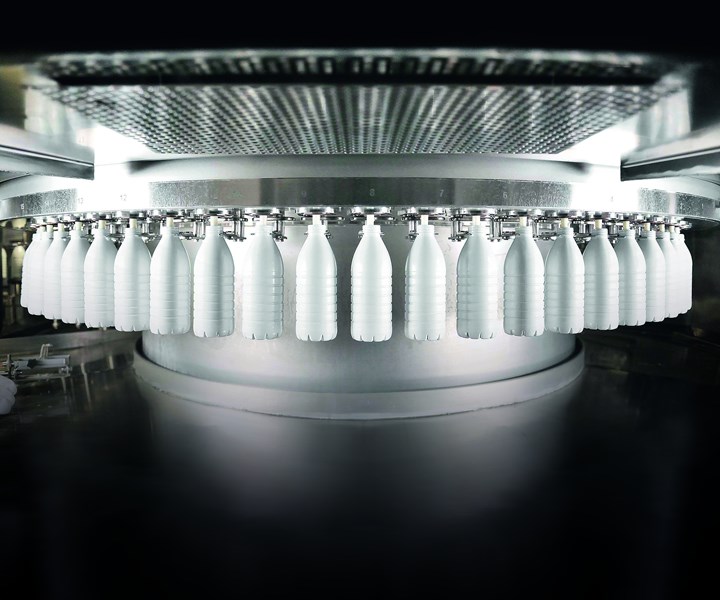Opaque White Bottle-to-Bottle Recycling Proven with 100% rPET
Swiss masterbatch producer Sukano and French PET bottle machinery builder Sidel collaborated on a project to confirm the bottle-to-bottle recyclability of opaque white light-barrier PET dairy bottles.
Swiss masterbatch producer Sukano and French PET bottle machinery builder Sidel collaborated on a project to confirm the bottle-to-bottle recyclability of opaque white light-barrier PET dairy bottles. The firms report that white PET bottles could be made with up to 100% regrind from similar bottles with no detectable color change or loss of light barrier and at the same throughput rate.

Monolayer opaque white PET dairy bottles can be recycled back to new bottles at a 100% rate without losing light barrier or productivity. (Photo: Sidel)
Monolayer white bottles were made with a Sukano masterbatch and blown into bottles on Sidel’s latest-generation EvoBlow two-stage rotary machine. The bottles were then recycled according to the European PET Bottle Platform (EBPB) protocol. This included melt filtration; no agglomerates were found. Solid-state polymerization (SSP) restored the IV to a level of 0.7-0.8. New bottles were made from 25%, 50% and 100% recyclate and additional Sukano white PET masterbatch (except for the 100% rPET bottles). In all cases, light barrier was confirmed for extreme conditions, such as less than 0.1% light transmission at 550 nm wavelength. “We saw no measurable difference in processing conditions or blowing output while processing the 100% recycled white PET material from Sukano white masterbatches, even under most challenging conditions,” said Naima Boutroy, Sidel global packaging expert.
Related Content
-
How to Extrusion Blow Mold PHA/PLA Blends
You need to pay attention to the inherent characteristics of biopolymers PHA/PLA materials when setting process parameters to realize better and more consistent outcomes.
-
How Inline Vision Inspection Can Minimize Scrap in Molding
Once viewed by injection and blow molders as a necessary evil, machine vision technology today can continuously monitor and improve production while reducing costs.
-
Get Color Changes Right In Extrusion Blow Molding
Follow these best practices to minimize loss of time, material and labor during color changes in molding containers from bottles to jerrycans. The authors explore what this means for each step of the process, from raw-material infeed to handling and reprocessing tails and trim.












